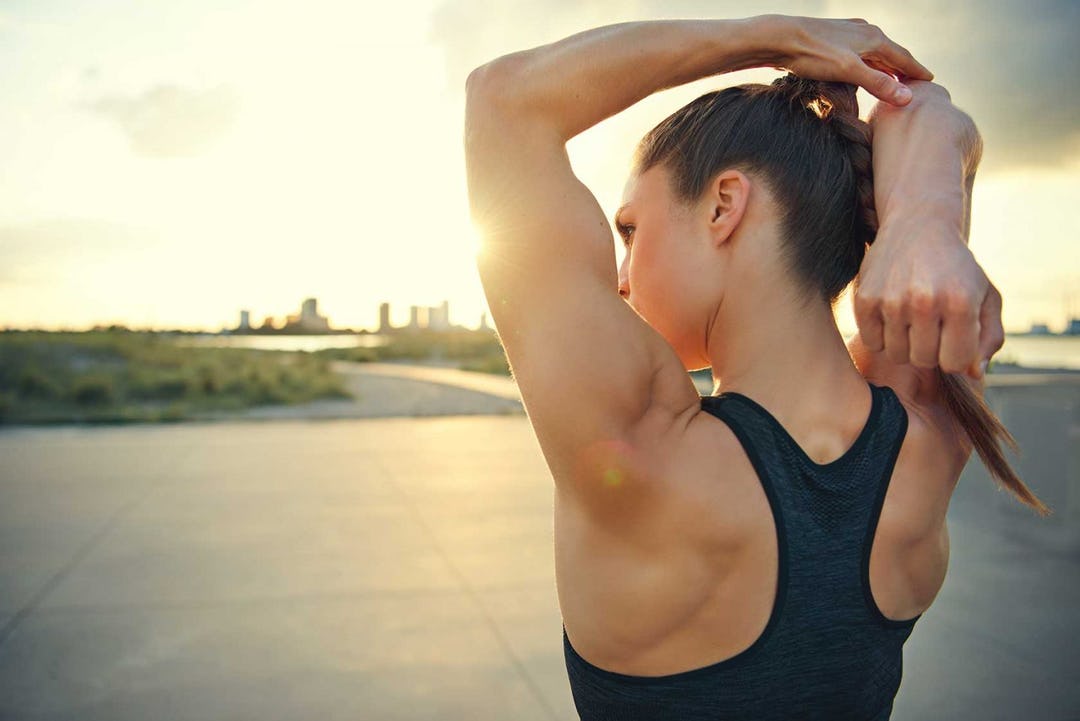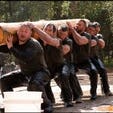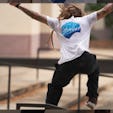Guys love their arm training. Ladies? Most of the time, we’d rather work butt and legs—probably because we’re more likely to get noticed (and judged) on those areas by both sexes than we are on our biceps. But with that said, adding some muscle to the bi’s and tri’s is the secret to having the kind of toned, athletic arms that look great in tanks, halters, and little black dresses.
The Best Arm Workouts For Getting Toned and Losing Fat
Whether you’re entirely new to lifting or are just looking to add more definition to your arms, we’ve got the master list of exercises and workouts you need to do for beautiful lines from your shoulders to wrists.
The Best Arm Exercises for Women
First, let’s clear up a popular misconception. Your muscles and your skeleton are structurally very similar to a man’s, so the same kinds of exercises your boyfriend uses to work his arms will work for you as well. By the same token, they won’t give you arms like his. Women don’t have the same levels of testosterone that men do, so building mountains of muscle just isn’t a big risk.
However, this isn’t to say that copy and pasting your man’s arm routine will optimize your development. There are some specific movements we bet will help you reach your arm goals a little more efficiently than doing just any old curl or triceps extension.
The following are my favorite arm exercises to program for women.
Dumbbell Shoulder Press Exercise
When a woman sees another lady with great arms, what she notices first are her shoulders. Having round, smooth caps on top of your toned arms gives the entire arm a more complete look. Plus, shoulder work contributes greatly to overall upper-body strength.
Because it’s a compound movement, a dumbbell shoulder press works a lot more muscle than just curls or extensions alone. An overhead press activates muscle at the shoulder joints and the elbows, so it works the triceps as well as the deltoids, and lets you handle heavier weights—another factor in recruiting more overall muscle. When you do them standing, your core also gets activated.
If you don’t already have a day dedicated to shoulder training, or do a few shoulder exercises during the week, add shoulder presses into the mix. You can throw them into any upper-body workout, or use them to start off an arm day.
Step 1: Stand with your feet shoulder-width apart with a slight bend in your knees. Bring the dumbbells to collarbone height, with your elbows in front of your body, palms facing forward.
Step 2: Engage your core and use your shoulders to press the weight over your head. At the top, ensure you’re completely locked out by bringing your head through so your ears are next to your elbows.
Step 3: Slowly bring the weights back down to collarbone level. As you bring the weights down, don’t relax. Keep everything engaged through the entire set.
Technique Tips: You may feel yourself arching your back to get the weights up. Refrain from doing this. Squeeze your butt as you press and think about keeping your ribs pulled down and core tight. Don’t allow the dumbbells to float away from your body at the top of the movement. Keep them on top of your shoulders.
Face Pull Exercise
Many people fail to train all the parts of the shoulders evenly, and that can lead to imbalances that cause injury. The deltoid muscle has three heads—front, middle, and rear—and most shoulder exercises hit the front and middle while the rear delt (on the back of the shoulder) gets neglected.
The face pull focuses on the rear delts and upper back, improving posture so that your shoulders, arms, and chest all look more prominent.
Step 1: Set the pulley on a cable machine to eye level or above. You can use a rope attachment or two single-grip handles. If you don’t have a cable station, attach a band to a sturdy object instead.
Step 2: Hold the handles in each hand with your thumbs facing each other. Step away from the machine so your arms are extended and take a staggered stance. This is where you’ll start.
Step 3: Pull the handles toward your face. They should finish at your forehead or jaw. Hold the end position (your upper back fully contracted) for a second and then return to the starting position.
Technique tips: Try not to move any part of your body other than your shoulders and elbows. Choose a weight that’s challenging but allows you to perform smooth reps.
Pushup Exercise
As mentioned above, pressing/pushing of any kind will engage your triceps, but I like to use the pushup whenever possible, because it gives you so much bang for your workout buck.
You don’t need any equipment and it strengthens your entire upper body and core, and the closer together you place your hands, the more emphasis you place on the triceps.
I also like programming pushups for women because they are so easily scalable. If they’re difficult for you, you can put your hands on a bench or a chair so your upper body is on an incline. That will reduce the amount of bodyweight you have to lift. If you want to make pushups more difficult, elevate your feet on a chair or bench.
Step 1: Lie on the floor on your stomach. Place your hands under your body, about shoulder-width apart. Flex your feet so your toes are on the ground and your heels are in the air.
Step 2: Tuck your tailbone under so your pelvis is perpendicular to the ground. Brace your core, squeeze your legs, and press your upper body off the floor until your elbows are completely extended. Keep your arms in close to your sides. Slowly lower until your chest is just above the floor to begin the next rep.
Technique tips: Don’t allow your lower back to sag toward the floor. Keep your abs braced like you’re about to take a punch to the gut, and squeeze your glutes.
Overhead Cable Triceps Extension
Your triceps have three heads (hence the “tri” in the name). This movement is great for training the long head, which runs down the innermost side of your arm and provides most of the muscle’s strength. Using a cable helps keep tension on the muscle throughout the range of motion, so even when your arms are locked out, the triceps are still working.
Step 1: Attach a rope handle (or two single-grip handles) to the top pulley of a cable station. Grasp it with both hands and face away from the station, reaching your arms overhead with elbows bent. You should feel a slight stretch in the muscles. Stagger your stance for balance.
Step 2: Extend your elbows to lockout, and control their return to the starting position.
Technique tips: Don’t let your lower back arch as you do this movement, and try not to move anything other than your elbow joint!
Hammer Curl Exercise
Hammer curls hit the brachioradialis, the main forearm muscle. This area tends to be underworked because people like to favor the biceps, and stronger forearm muscles help to stabilize the elbow joint, reducing the risk of injury—especially if you do activities outside the gym like golf or tennis.
Step 1: Stand with your feet shoulder-width apart and make a slight bend in your knees. Hold a dumbbell in each hand, your palms facing each other.
Step 2: Keeping that same neutral grip (palms facing in), bend your elbows and bring the dumbbells up as you would a hammer. You should feel your biceps flex as you do this. When the top of the dumbbell gets to about shoulder-level, lower it back down to the starting position. You can lift with both arms at the same time, or alternate arms.
Technique tips: It can be really easy to throw your hips, lower back, and even your shoulders into this exercise in order to move the dumbbell. Engage your core and squeeze your butt to keep everything but your arms still.
Barbell Curl Exercise
Barbell curls are a solid, basic movement that works the biceps completely. Just remember to keep your elbows from coming up and away from your body. To ensure that the biceps do the work and not the front deltoids, keep your elbows at your sides.
The advantage to using a barbell over dumbbells is exposing your muscles to heavier loads. But if a straight bar bothers your wrists or elbows, you can get the same training effect from an EZ-curl bar (the bar with waves in it so that when you grip it your wrists are at an angle).
Step 1: Stand with your feet shoulder-width apart and make a slight bend in your knees. Hold the barbell with your palms facing up, hands shoulder width.
Step 2: Engage your core, squeeze your butt, and bend your elbows to bring the barbell up to shoulder level. Squeeze your biceps at the top, and lower back down.
Technique tips: As you get tired, you may feel like swinging the weight up. Keep good form. End the set before your technique breaks down.
How To Stretch Your Arms
Just like you’d do before any other workout, it’s important to warm up your arms before you train them. A good warmup will prime your muscles for the work they’re about to do and help to prevent injury. Use these two mobility drills from Onnit’s Durability Coach, Cristian Plascencia, before any arm training.
Get Toned With These Arm Workouts
The best arm workout for you depends on your goals and experience level. Choose from the options below to find the right routine.
Beginner Arm Workout
If you’re fairly new (or brand new) to the gym, your priority should be to strengthen your biggest muscle groups. It’s a matter of efficiency: by concentrating on improving overall upper-body strength with compound exercises that let you lift heavy and work several muscles at once, you’ll see growth everywhere. At this stage in your training, you don’t need any direct arm work to get results.
Skeptical? The purpose of the biceps and triceps is to flex and extend the elbow. When you flex your arm (bend your elbow), you can feel your biceps contract. When you extend your arm (make it straight), you can feel your triceps contract. This means that doing any pulling or pressing motion will activate those muscles. So doing lat pulldowns and rows—primarily back exercises—will work your biceps just like curls do. Likewise, pushups and bench and shoulder presses will train your triceps.
This workout is organized with supersets (marked A and B). You’ll do two exercises back to back, and after you’ve completed one set of each, rest. Supersets get your heart rate up, so you can also burn fat while you’re lifting. It’s a win-win!
Superset 1
1A Lat Pulldown
Sets: 3–4 Reps: 12–15 Rest: 0 sec.
Sit at a lat pulldown station, and secure your knees under the pads. Grasp the bar with hands at shoulder width and your palms facing forward. Pull the bar to your collarbone, and control its path back up.
1B Dumbbell Shoulder Press
Sets: 3–4 Reps: 12–15 Rest: 1–2 minutes
See the directions above.
Superset 2
2A Bentover Row
Sets: 2–3 Reps: 10–12 Rest: 0 sec.
Place a barbell on a rack set to about hip level. Grasp the bar with your hands at shoulder width, and pull the bar out of the rack. Step back, and set your feet at hip width, holding the bar at arm’s length against your thighs. Take a deep breath, and bend your hips back—keeping your head, spine, and pelvis aligned. Bend until your torso is nearly parallel to the floor. Draw your shoulder blades together as you pull the bar up to your belly button.
2B Pushup
Sets: 2–3 Reps: 10–12 Rest: 1–2 minutes
See the directions above.
Superset 3
3A EZ-Bar Curl
Sets: 2 Reps: 12 Rest: 0 sec.
See the directions above.
3B Overhead Cable Triceps Extension
Sets: 2 Reps: 12 Rest: 1–2 minutes
See the directions above.
Arm Day Workout
This workout is for you gals who have been lifting consistently for several months or more and want to target the arms more directly. As I said before, in my experience, women who want nice-looking arms really have to start with the shoulders, so while you’ll do curls and extensions here, I’m also adding some shoulder work too.
If you already have a shoulder day, you can cut back on the reps and sets on the shoulder movements, or just make sure you give yourself two or three days between your shoulder day and this workout.
For this workout, we’re just going to do all the sets and exercises straight through. Meaning, you’ll start with the face pull and do all the sets for it before moving on to the dumbbell front raise, and so on. Focusing on one exercise at a time helps you avoid excess fatigue and lets you use heavier weights.
Rest as necessary, but I suggest limiting your rest to 60 seconds between sets.
Face Pull
Sets: 4 Reps: 12
See the directions above.
Dumbbell Front Raise
Sets: 4 Reps: 12
Stand holding a pair of dumbbells at arm’s length in front of you. Draw your shoulder blades down and together (think: “proud chest”) and raise them up in front of your body to shoulder level. Keep a slight bend in your elbows.
Hammer Curl
Sets: 3 Reps: 10 (each arm)
See the directions above.
Barbell Curl
Sets: 3 Reps: 12, as many as possible
See the directions above. Perform two sets of 12 reps, and then reduce the weight by 10% and do as many reps as possible.
Overhead Cable Triceps Extension
Sets: 3 Reps: 15
See the directions above.
Bench Dip
Sets: 3 Reps: As many as possible
Stand in front of a bench and place your hands on it behind you. Extend your legs in front of you and lower your body until your upper arms are parallel to the floor. Press into the bench to extend your elbows.
Arm Finisher Workout
If you’re an experienced trainee already on a full-body or upper body/lower body split, this arms finisher is the perfect way to end it.
The point of this workout is to add a little bit of extra work to your arms without having to radically overhaul your workouts. Throw this mini-routine on at the end of any workout you do twice per week.
Choose any biceps and triceps exercise. For example, barbell curls and overhead cable extensions. Now do countdown sets for each, starting at 10 reps.
So you’ll do 10 curls and then 10 extensions with no rest in between. Then you’ll go back to the curls and do 9 reps, and then extensions for 9 reps. Continue all the way down to 1 rep for each exercise.
It will look like this:
Curl x 10 reps
Overhead Cable Triceps Extension x 10 reps
Curl x 9
Overhead Cable Triceps Extension x 9
Curl x 8
Overhead Cable Triceps Extension x 8…
Curl x 1
Overhead Cable Triceps Extension x 1
At-Home Workout
If you train in a home gym (or your living room, with the coffee table pushed out of the way), all you need for a great arm workout is a single dumbbell or kettlebell.
To do this workout, you’ll go through a set of each exercise, one after the other, without rest. You’ll rest after you’ve completed one full round of the exercises. Do 3–4 rounds, resting up to 2 minutes between rounds.
Decline Pushup
Reps: 8–10
Set up as you would to do a normal pushup, but rest your feet on a bench or other surface so they’re elevated.
Plank Walkout
Reps: 10
From your pushup position, keep a long spine and your core braced. Walk your hands forward as far as you can without letting your lower back sag toward the floor. Walk back. That’s one rep.
One-Arm Dumbbell Row
Reps: 10 (each arm)
Rest your left knee and hand on a bench or chair and grasp a dumbbell with your right hand. Let the weight hang straight down. Retract your shoulder and row the dumbbell up to your side. Lower the weight back to the starting position.
One-Arm Z Press
Reps: 8 (each arm)
Sit on the floor with a dumbbell in one hand at shoulder level and your legs extended in front of you. Keep your torso as upright as you can and press the weight straight overhead.
Bench Dip
Reps: 15
See the directions above.
Superman Row
Reps: 10
Lie on your belly on the floor holding a light weight in each hand (or your bodyweight alone may be enough). Extend your arms overhead. Squeeze your glutes and raise your torso off the floor as high as you can and pull your arms down, bending your elbows and drawing them to your sides as if doing a lat pulldown.
How To Lose Arm Fat
Unfortunately, you don’t get to decide where your body will lose fat from first. Where you gain and lose weight has a lot to do with your genetics, and can be influenced by health issues. So if you suffer from a little extra arm flab that waves at people whenever you do, there’s no workout you can do to specifically target and destroy it.
However, by gaining muscle and revamping your diet, you can firm up your arms and lose the fat that currently covers them. For guidance on eating better, see these other articles on the keto diet and the caveman diet (also great for cave-females).
Remember also that shapely, toned arms can only come from resistance training, and lifting weights is the best form of resistance. Further, results come from lifting weights that are heavy. You need to be expending effort as you lift, not just throwing around reps with a soup can in each hand.
As I mentioned in the beginning, most women don’t have the hormone profile to build muscle like men do, so heavy lifting won’t result in so-called “manly” arms. Also, building muscle is flat out really hard to do, whether you’re a woman or a man. Don’t make it harder than it has to be by challenging yourself any less.
Here’s the thing about how building muscle and burning fat works. Muscle takes up a lot of energy to create and to retain. That energy comes directly from the food you eat and the calories you’ve already stored. If you work on building muscle, and you’re not overeating, your body will have no choice but to oxidize fat to help grow and maintain your muscles. Your metabolism will be elevated all day long, even when you’re relaxing on the couch.
That’s one of the best parts about having more muscle mass: you can burn fat even when you’re doing a whole lotta nothing.


)





